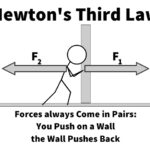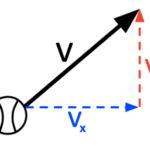According to Newton’s third law, for every action force there is an equal (in size) and opposite (in direction) reaction force. Forces always come in pairs – known as “action-reaction force pairs.” Identifying and describing action-reaction force pairs is a simple matter of identifying the two interacting objects and making two statements describing who is pushing on whom and in what direction. For example, consider the interaction between a baseball bat and a baseball.

The baseball forces the bat to the left; the bat forces the ball to the right. Together, these two forces exerted upon two different objects form the action-reaction force pair. Note that in the description of the two forces, the nouns in the sentence describing the forces simply switch places.
Consider the following three examples. One of the forces in the mutual interaction is described; describe the other force in the action-reaction force pair. Click the button to view the answer.

Baseball pushes glove leftwards.

The glove pushes the baseball rightward.

Bowling ball pushes pin leftwards.

Pin pushes bowling ball rightward.

Enclosed air particles push balloon wall outwards.
Balloon wall pushes enclosed air particles inwards.
close
Check Your Understanding
1. Consider the interaction depicted below between foot A, ball B, and foot C. The three objects interact simultaneously (at the same time). Identify the two pairs of action-reaction forces. Use the notation “foot A”, “foot C”, and “ball B” in your statements. Click the button to view the answer.


The first pair of action-reaction force pairs is: foot A pushes ball B to the right; and ball B pushes foot A to the left. The second pair of action-reaction force pairs is: foot C pushes ball B to the left; and ball B pushes foot C to the right.
close
2. Identify at least six pairs of action-reaction force pairs in the following diagram.


The elephant’s feet push backward on the ground; the ground pushes forward on its feet. The right end of the right rope pulls leftward on the elephant’s body; its body pulls rightward on the right end of the right rope. The left end of the right rope pulls rightward on the man; the man pulls leftward on the left end of the right rope. The right end of the left rope pulls leftward on the man; the man pulls rightward on the right end of the left rope. The tractor pulls leftward on the left end of the left rope; the left end of the left rope pulls rightward on the tractor. etc., etc.


